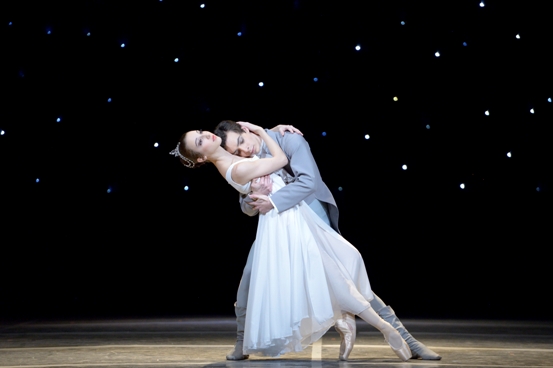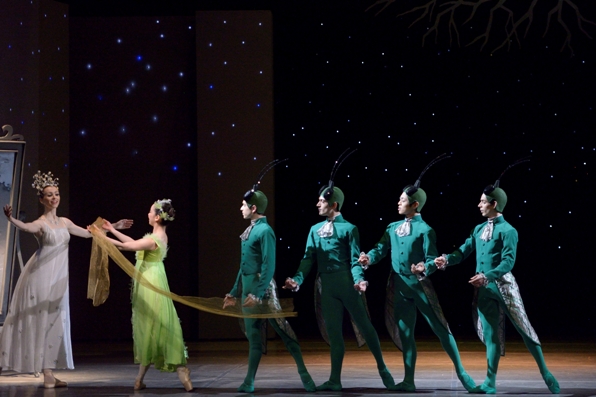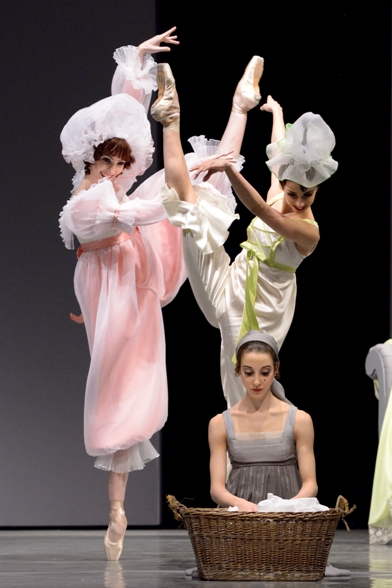 National Moravian-Silesian Theatre Ballet’s clever dramaturgy is always able to catch attention. This time it has come up with a surprisingly well-timed premiere of a title which belongs to the top classical ballet pieces of the 20th century and has been staged repeatedly in various Czech theatres. In Antonin Dvorak Theatre, the Cinderella ballet was premiered on 23 April 2015, on Sergei Sergeyevich Prokofiev’s unlived birthday (1891 – 1953). By coincidence, the performance was also held on the eve of the 70th anniversary of the end of WW2 and thus recalled the birth of Cinderella at the Great Theatre in Moscow in 1945 (choreographed by Rostislav Zakharov), in Leningrad’s Kirov Theatre in 1946 (choreographed by Constantine Sergeyev) and later in the National Theatre in Prague where Cinderella was first staged on 8 January 1948 by Sasha Makhov. He was the first choreographer who successfully transformed Prokofiev’s music score into a ballet piece without any links to the previous Russian versions and models. His Cinderella remained a part of the National Theatre’s repertoire until 1967, though Makhov himself fell into the disfavour of the political authorities - mainly due to his war-time activities within the British army and his cooperation with the Sadler’s Wells Theatre in London – and after a theatre affair in 1951 he committed suicide.
The premiere of Frederick Ashton’s famous version of Cinderella, performed up to these days by the Royal Ballet company and recorded on DVD, took place on 23 December 1948. Unlike the original Prokofiev’s conception inspired by Russian ballet ensembles and unlike the staging at the National Theatre Prague, Ashton’s ballet omits Prince’s travels across exotic countries where he is looking for his love with just the glass slipper to help him.
Paul Chalmer’s personal account
National Moravian-Silesian Theatre Ballet’s clever dramaturgy is always able to catch attention. This time it has come up with a surprisingly well-timed premiere of a title which belongs to the top classical ballet pieces of the 20th century and has been staged repeatedly in various Czech theatres. In Antonin Dvorak Theatre, the Cinderella ballet was premiered on 23 April 2015, on Sergei Sergeyevich Prokofiev’s unlived birthday (1891 – 1953). By coincidence, the performance was also held on the eve of the 70th anniversary of the end of WW2 and thus recalled the birth of Cinderella at the Great Theatre in Moscow in 1945 (choreographed by Rostislav Zakharov), in Leningrad’s Kirov Theatre in 1946 (choreographed by Constantine Sergeyev) and later in the National Theatre in Prague where Cinderella was first staged on 8 January 1948 by Sasha Makhov. He was the first choreographer who successfully transformed Prokofiev’s music score into a ballet piece without any links to the previous Russian versions and models. His Cinderella remained a part of the National Theatre’s repertoire until 1967, though Makhov himself fell into the disfavour of the political authorities - mainly due to his war-time activities within the British army and his cooperation with the Sadler’s Wells Theatre in London – and after a theatre affair in 1951 he committed suicide.
The premiere of Frederick Ashton’s famous version of Cinderella, performed up to these days by the Royal Ballet company and recorded on DVD, took place on 23 December 1948. Unlike the original Prokofiev’s conception inspired by Russian ballet ensembles and unlike the staging at the National Theatre Prague, Ashton’s ballet omits Prince’s travels across exotic countries where he is looking for his love with just the glass slipper to help him.
Paul Chalmer’s personal account
 Canadian choreographer Paul Chalmer, author of the Ostrava version of Cinderella, was inspired by Frederick Ashton’s choreography and created his own conception of optical expression of Prokofiev’s music.
Not only did he narrate the story through dance but also through acting. Chalmer’s choreographic style, based on neoclassical technique, reveals the long-term engagements with John Cranko‘s company in Stuttgart, in Les Ballets de Monte-Carlo and other leading European ballet ensembles. His Cinderella premiered last year in the Grand Theatre in Poznan and was brought to Ostrava as a well-proven title, created by an experienced ballet professional who is able to build on the interpretation skills of the company and to achieve a maximum effect using economical expressive means.
The scenography and costumes designed by Anna Kontek set Cinderella’s story into the Empire style. Simple colours and rather loose silhouette of female costumes help to draw the audience’s attention to the principal characters, to the simple-minded world of the Stepmother and her daughters, to its vanity and selfishness. At the ball, ladies are wearing white gowns and gentlemen are in black, Cinderella is clad in a white and later in grey costume, in fact she does not differ from the rest of the ladies at the ball and yet she catches the eye of the Prince. The white colour also appears on the costume of the Good Fairy who is accompanied by Fairies in soft-coloured long dresses. The dominating role of the Wicked Stepsisters is accentuated by the distinct colours and shapes of their costumes and by the strong, explicit features of their characters.
The harmony between stage actions and music was created by the opera orchestra of the NMST and the conductor Jakub Klecker whose interpretation reveals the sound plasticity of Prokofiev’s score and corresponds with the choreographic structure.
“All the action in Cinderella could lead to a pantomimic expression,” wrote Sasha Makhov into the programme to his 1948 Cinderella. “Yet Prokofiev’s music goes against that – it encourages to “act” the role through dance, even if the given classical variation determines the choice of dance technique. Prokofiev intended to make Cinderella a classical ballet and it is a task for the choreographer to imbue this classical form with life and realism, to give the characters and the music a strong movement addition. A task even more difficult as Prokofiev’s music surpasses the old schemes, still respecting the classical forms and filling them with new meaning. All that imposes new, unusual requirements on the performers: to enrich the familiar dance language with a new accent and expression.”
From ballet mannerism to dance expressionism
To endow Chalmer’s neoclassical vocabulary with meaningful expression is a task for the dancers. Cinderella’s character seems to be rather uncomplicated. She is supposed to be humble, hard-working, with rich spiritual life. Chiara Lo Piparo dances the role with strong technique and convincing inner motivation. Her movements please the eye of the audience, but her acting can still be improved – namely in the passages where Cinderella’s assiduity is to be expressed. It is Sergio Méndez Romero’s (the Prince) physique and masterful dance performance that creates the perfect image of Cinderella’s homme fatale who brings a blast of fresh emotions and hopes into the new phase of her life.
Cinderella’s Wicked Stepsisters and their mother, cruel Stepmother, are usually the stumbling-stone of movement interpretation. The dance vocabulary of classical ballet is essentially “beautiful” and expresses negative human qualities by conventionalised acting mannerism. Paul Chalmer defined the “evil” of both sisters by the inappropriateness of their appearance – one of them is fat (she’s eating constantly) and the other too thin (she’s always prinking herself up). The dance erudition and comic talent of Markéta Pospíšilová (The Fat Sister) and Barbora Šulcová (The Thin Sister) transformed the negative characters into funny protagonists of the story. The dancers play with the Sisters’ silly qualities - they bicker all the time and beat the poor Cinderella, as does their mother (Petra Kováčová). However, in the dance antagonism of “good” and “evil” we seem to miss the educational purpose of the fairy tale conflict in which Cinderella’s hardships stem from the laziness and spiritual as well as emotional shallowness of her family.
Concluding remark
Canadian choreographer Paul Chalmer, author of the Ostrava version of Cinderella, was inspired by Frederick Ashton’s choreography and created his own conception of optical expression of Prokofiev’s music.
Not only did he narrate the story through dance but also through acting. Chalmer’s choreographic style, based on neoclassical technique, reveals the long-term engagements with John Cranko‘s company in Stuttgart, in Les Ballets de Monte-Carlo and other leading European ballet ensembles. His Cinderella premiered last year in the Grand Theatre in Poznan and was brought to Ostrava as a well-proven title, created by an experienced ballet professional who is able to build on the interpretation skills of the company and to achieve a maximum effect using economical expressive means.
The scenography and costumes designed by Anna Kontek set Cinderella’s story into the Empire style. Simple colours and rather loose silhouette of female costumes help to draw the audience’s attention to the principal characters, to the simple-minded world of the Stepmother and her daughters, to its vanity and selfishness. At the ball, ladies are wearing white gowns and gentlemen are in black, Cinderella is clad in a white and later in grey costume, in fact she does not differ from the rest of the ladies at the ball and yet she catches the eye of the Prince. The white colour also appears on the costume of the Good Fairy who is accompanied by Fairies in soft-coloured long dresses. The dominating role of the Wicked Stepsisters is accentuated by the distinct colours and shapes of their costumes and by the strong, explicit features of their characters.
The harmony between stage actions and music was created by the opera orchestra of the NMST and the conductor Jakub Klecker whose interpretation reveals the sound plasticity of Prokofiev’s score and corresponds with the choreographic structure.
“All the action in Cinderella could lead to a pantomimic expression,” wrote Sasha Makhov into the programme to his 1948 Cinderella. “Yet Prokofiev’s music goes against that – it encourages to “act” the role through dance, even if the given classical variation determines the choice of dance technique. Prokofiev intended to make Cinderella a classical ballet and it is a task for the choreographer to imbue this classical form with life and realism, to give the characters and the music a strong movement addition. A task even more difficult as Prokofiev’s music surpasses the old schemes, still respecting the classical forms and filling them with new meaning. All that imposes new, unusual requirements on the performers: to enrich the familiar dance language with a new accent and expression.”
From ballet mannerism to dance expressionism
To endow Chalmer’s neoclassical vocabulary with meaningful expression is a task for the dancers. Cinderella’s character seems to be rather uncomplicated. She is supposed to be humble, hard-working, with rich spiritual life. Chiara Lo Piparo dances the role with strong technique and convincing inner motivation. Her movements please the eye of the audience, but her acting can still be improved – namely in the passages where Cinderella’s assiduity is to be expressed. It is Sergio Méndez Romero’s (the Prince) physique and masterful dance performance that creates the perfect image of Cinderella’s homme fatale who brings a blast of fresh emotions and hopes into the new phase of her life.
Cinderella’s Wicked Stepsisters and their mother, cruel Stepmother, are usually the stumbling-stone of movement interpretation. The dance vocabulary of classical ballet is essentially “beautiful” and expresses negative human qualities by conventionalised acting mannerism. Paul Chalmer defined the “evil” of both sisters by the inappropriateness of their appearance – one of them is fat (she’s eating constantly) and the other too thin (she’s always prinking herself up). The dance erudition and comic talent of Markéta Pospíšilová (The Fat Sister) and Barbora Šulcová (The Thin Sister) transformed the negative characters into funny protagonists of the story. The dancers play with the Sisters’ silly qualities - they bicker all the time and beat the poor Cinderella, as does their mother (Petra Kováčová). However, in the dance antagonism of “good” and “evil” we seem to miss the educational purpose of the fairy tale conflict in which Cinderella’s hardships stem from the laziness and spiritual as well as emotional shallowness of her family.
Concluding remark
 There is no doubt the National Moravian-Silesian Theatre has prepared a ballet production for a wide spectre of audiences and thus added another piece into the mosaic of Prokofiev’s ballets tradition that was started in Ostrava by the ballet company director Emrich Gabzdyl. As a choreographer, he put through the first foreign staging of Prokofiev’s Stone Flower (1958), the first televised version of the composer’s ballet Chout - under the title The Tale of the Buffoon who Outwits Seven Other Buffoons (1967) - and the first Ostrava premiere of Cinderella (1971). But at the times of Emrich Gabzdyl, the ballet company had fifty members, while its current director Lenka Dřímalová can only work with twenty-eight dancers. With such a small number of performers it is almost impossible to stage a piece with alternating casts or a big classical title requiring an adequate number of performers. That is why the Cinderella ballet involves many externs – the students of the Janacek Conservatory and Grammar School in Ostrava, members of the NMST ballet studio and others. Due to the injury of one of the protagonists, the second premiere had to be recast in a very short time as there were not enough dancers in the ensemble.
Compared to the ballet companies of the National Theatre in Prague and National Theatre in Brno, the NMST ensemble still resembles the humble Cinderella. The only positive twist in its existence could be brought about by the increase in the number of dancers so it would match the company’s position in the theatre hierarchy in the “Lands of the Bohemian Crown”.
Written from the premiere held on 23 April 2015 in Antonin Dvorak Theatre, NMST Ostrava.
Cinderella
There is no doubt the National Moravian-Silesian Theatre has prepared a ballet production for a wide spectre of audiences and thus added another piece into the mosaic of Prokofiev’s ballets tradition that was started in Ostrava by the ballet company director Emrich Gabzdyl. As a choreographer, he put through the first foreign staging of Prokofiev’s Stone Flower (1958), the first televised version of the composer’s ballet Chout - under the title The Tale of the Buffoon who Outwits Seven Other Buffoons (1967) - and the first Ostrava premiere of Cinderella (1971). But at the times of Emrich Gabzdyl, the ballet company had fifty members, while its current director Lenka Dřímalová can only work with twenty-eight dancers. With such a small number of performers it is almost impossible to stage a piece with alternating casts or a big classical title requiring an adequate number of performers. That is why the Cinderella ballet involves many externs – the students of the Janacek Conservatory and Grammar School in Ostrava, members of the NMST ballet studio and others. Due to the injury of one of the protagonists, the second premiere had to be recast in a very short time as there were not enough dancers in the ensemble.
Compared to the ballet companies of the National Theatre in Prague and National Theatre in Brno, the NMST ensemble still resembles the humble Cinderella. The only positive twist in its existence could be brought about by the increase in the number of dancers so it would match the company’s position in the theatre hierarchy in the “Lands of the Bohemian Crown”.
Written from the premiere held on 23 April 2015 in Antonin Dvorak Theatre, NMST Ostrava.
CinderellaChoreography (based on the fairy tale by Charles Perrault): Paul Chalmer
Music: Sergej Sergejevič Prokofjev
Orchestra rehearsals director and conductor: Jakub Klecker
Sets and costumes: Anna Konteková Author: Jana Hošková Translation: Tereza Cigánková



